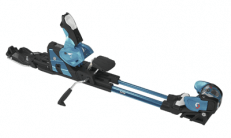Skibindings – GearGuide
 With only the right skis you are not home safe yet, as far as putting your ski kit together. The correct bindings are just as important. Your bindings play a crucial role when it comes to safety.
With only the right skis you are not home safe yet, as far as putting your ski kit together. The correct bindings are just as important. Your bindings play a crucial role when it comes to safety.
Image: Scott BC 16 Guardian B100 Binding
The ski bindings transmit the energy from every move you make, and the pressure you exert, to your skis. This is literally the ‘connection’ between the ski boot and the ski. The complexity of the binding is that on the one hand, it needs to connect well to your boot, hold it fast, give a stable feel and transmit that energy efficiently, while on the other hand, it needs to come off quickly if you do fall. For a beginner, it is quite important to choose bindings that you click on, and out, quickly.
The correct bindings
Bindings that are well dialed in and are used correctly increase your safety while skiing. Choose bindings that match your experience, level and ambition. Not all ski bindings match all ski boots and vice versa. So if you are not sure about what will fit your boot, take it along when you go to choose your bindings.
